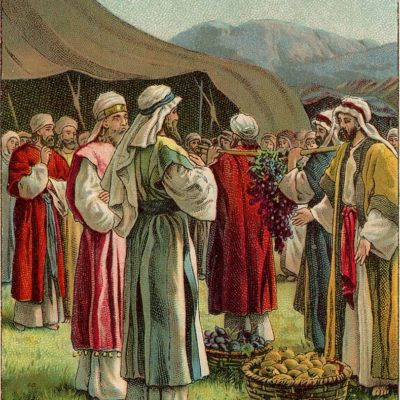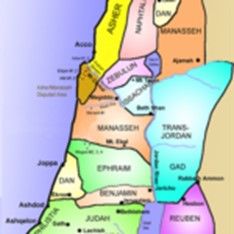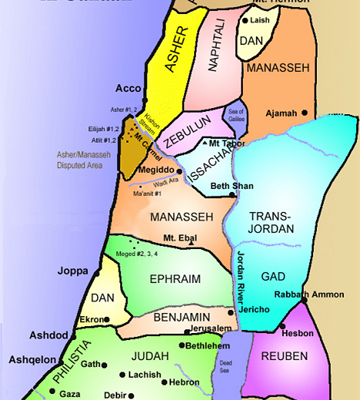Mount Hermon
Mount Hermon, which means “sanctuary”, is a mountain on the northeastern border of Palestine and Lebanon, overlooking the border city of Dan. the three-peaked summit at the southern end of the Anti-Lebanon mountain range. Mount Hermon rises 9,230 feet above sea level and is the highest point in the entire Levant, 1,968 feet higher than any part of the Lebanon Mountains and towering above the Bashan plateau and upper Jordan Valley. (Baly. 2011).
Mount Hermon is located in the anti-Lebanon mountain range. It is on the border between Lebanon and Syria. The summit of Mount Hermon is under the control of Syria, however, the southern and western slopes are under the control of Israel, and is part of the Golan Heights. These slopes were unilaterally annexed by Israel in 1980 with the conclusion and victory of the Six Day War in 1967. (Dar. 1993).
Mount Hermon has three separate summits that are covered most of the year with snow. The run off of Mount Hermon supplies water to the rivers and streams that merge to the Jordan River. The modern name is Jebel-esh-Sheikh.
Mount Hermon was called Senir by the Amorites, and Sirion by the Sidonians.“([Which] Hermon the Sidonians call Sirion; and the Amorites call it Shenir)” (Deuteronomy 3:9).
Mount Hermon serves as the northern boundary of the Promised Land.
“And we took at that time out of the hand of the two kings of the Amorites the land that [was] on this side Jordan, from the river of Arnon unto Mount Hermon;” (Deuteronomy 3:8).
It is the northern limit of the occupation of the kingdoms by Joshua to possess their land.
“As the LORD commanded Moses his servant, so did Moses command Joshua, and so did Joshua; he left nothing undone of all that the LORD commanded Moses. So Joshua took all that land, the hills, and all the south country, and all the land of Goshen, and the valley, and the plain, and the mountain of Israel, and the valley of the same; [Even] from the mount Halak, that goeth up to Seir, even unto Baalgad in the valley of Lebanon under mount Hermon: and all their kings he took, and smote them, and slew them. Joshua made war a long time with all those kings.” (Joshua 11:15-18).
Og king of Bashan, which was of the remnant of the giants, reigned in mount Hermon.
“Now these [are] the kings of the land, which the children of Israel smote, and possessed their land on the other side Jordan toward the rising of the sun, from the river Arnon unto mount Hermon, and all the plain on the east: Sihon king of the Amorites, who dwelt in Heshbon, [and] ruled from Aroer, which [is] upon the bank of the river Arnon, and from the middle of the river, and from half Gilead, even unto the river Jabbok, [which is] the border of the children of Ammon; And from the plain to the sea of Chinneroth on the east, and unto the sea of the plain, [even] the salt sea on the east, the way to Bethjeshimoth; and from the south, under Ashdothpisgah: And the coast of Og king of Bashan, [which was] of the remnant of the giants, that dwelt at Ashtaroth and at Edrei, And reigned in mount Hermon, and in Salcah, and in all Bashan, unto the border of the Geshurites and the Maachathites, and half Gilead, the border of Sihon king of Heshbon. Them did Moses the servant of the LORD and the children of Israel smite: and Moses the servant of the LORD gave it [for] a possession unto the Reubenites, and the Gadites, and the half tribe of Manasseh.” (Joshua 12:1-6).
Joshua had grown old and had not possessed the land that the LORD GOD had commanded. The LORD GOD promised to drive out the occupants of the lands, including Mount Hermon, so they could be divided by lot to the Israelites for an inheritance.
“Now Joshua was old [and] stricken in years; and the LORD said unto him, Thou art old [and] stricken in years, and there remaineth yet very much land to be possessed. This [is] the land that yet remaineth: all the borders of the Philistines, and all Geshuri, From Sihor, which [is] before Egypt, even unto the borders of Ekron northward, [which] is counted to the Canaanite: five lords of the Philistines; the Gazathites, and the Ashdothites, the Eshkalonites, the Gittites, and the Ekronites; also the Avites: From the south, all the land of the Canaanites, and Mearah that [is] beside the Sidonians, unto Aphek, to the borders of the Amorites: And the land of the Giblites, and all Lebanon, toward the sunrising, from Baalgad under mount Hermon unto the entering into Hamath. All the inhabitants of the hill country from Lebanon unto Misrephothmaim, [and] all the Sidonians, them will I drive out from before the children of Israel: only divide thou it by lot unto the Israelites for an inheritance, as I have commanded thee. (Joshua 13:1-6).
Mount Hermon was part of the division of land for inheritance by the nine tribes.
“Now therefore divide this land for an inheritance unto the nine tribes, and the half tribe of Manasseh, With whom the Reubenites and the Gadites have received their inheritance, which Moses gave them, beyond Jordan eastward, [even] as Moses the servant of the LORD gave them; From Aroer, that [is] upon the bank of the river Arnon, and the city that [is] in the midst of the river, and all the plain of Medeba unto Dibon; And all the cities of Sihon king of the Amorites, which reigned in Heshbon, unto the border of the children of Ammon; And Gilead, and the border of the Geshurites and Maachathites, and all mount Hermon, and all Bashan unto Salcah; All the kingdom of Og in Bashan, which reigned in Ashtaroth and in Edrei, who remained of the remnant of the giants: for these did Moses smite, and cast them out.” (Joshua 13:7-12).
Half the Tribe of Manasseh was given the Mount Hermon as part of their inheritance to possess.
“And Moses gave [inheritance] unto the half tribe of Manasseh: and [this] was [the possession] of the half tribe of the children of Manasseh by their families. And their coast was from Mahanaim, all Bashan, all the kingdom of Og king of Bashan, and all the towns of Jair, which [are] in Bashan, threescore cities: And half Gilead, and Ashtaroth, and Edrei, cities of the kingdom of Og in Bashan, [were pertaining] unto the children of Machir the son of Manasseh, [even] to the one half of the children of Machir by their families.” (Joshua 13:29-31).
The city of Caesarea Philippi is at the southern base of Mount Hermon. Jesus Christ and His disciples journeyed north from Bethsaida on the Sea of Galilee to the city of Caesarea Philippi where he asked his disciples about who men say he was.
“When Jesus came into the coasts of Caesarea Philippi, he asked his disciples, saying, Whom do men say that I the Son of man am? And they said, Some [say that thou art] John the Baptist: some, Elias; and others, Jeremias, or one of the prophets. He saith unto them, But whom say ye that I am? And Simon Peter answered and said, Thou art the Christ, the Son of the living God. And Jesus answered and said unto him, Blessed art thou, Simon Barjona: for flesh and blood hath not revealed [it] unto thee, but my Father which is in heaven. And I say also unto thee, That thou art Peter, and upon this rock I will build my church; and the gates of hell shall not prevail against it. And I will give unto thee the keys of the kingdom of heaven: and whatsoever thou shalt bind on earth shall be bound in heaven: and whatsoever thou shalt loose on earth shall be loosed in heaven. Then charged he his disciples that they should tell no man that he was Jesus the Christ.” (Matthew 16:13-20).
It was also in this city of Caesarea Philippi that Jesus revealed to His disciples that He would build His church upon the Rock Peter and foretold of His purpose of going to Jerusalem to die and then be resurrected.
“And Jesus went out, and his disciples, into the towns of Caesarea Philippi: and by the way he asked his disciples, saying unto them, Whom do men say that I am? And they answered, John the Baptist: but some [say], Elias; and others, One of the prophets. And he saith unto them, But whom say ye that I am? And Peter answereth and saith unto him, Thou art the Christ. And he charged them that they should tell no man of him. And he began to teach them, that the Son of man must suffer many things, and be rejected of the elders, and [of] the chief priests, and scribes, and be killed, and after three days rise again. And he spake that saying openly. And Peter took him, and began to rebuke him. But when he had turned about and looked on his disciples, he rebuked Peter, saying, Get thee behind me, Satan: for thou savourest not the things that be of God, but the things that be of men. And when he had called the people [unto him] with his disciples also, he said unto them, Whosoever will come after me, let him deny himself, and take up his cross, and follow me. For whosoever will save his life shall lose it; but whosoever shall lose his life for my sake and the gospel’s, the same shall save it. For what shall it profit a man, if he shall gain the whole world, and lose his own soul? Or what shall a man give in exchange for his soul? Whosoever therefore shall be ashamed of me and of my words in this adulterous and sinful generation; of him also shall the Son of man be ashamed, when he cometh in the glory of his Father with the holy angels.” (Mark 8:27-38).
It was after six days when Jesus took Peter, James, and John up into a high mountain. It is very probable that high mountain was Mount Hermon. This is where the transfiguration of Jesus took place and the exchange with Jesus, Moses and Elijah. It is also where the LORD GOD was heard exclaiming. “This is my beloved Son, with whom I am well pleased; listen to Him!”
“And after six days Jesus taketh Peter, James, and John his brother, and bringeth them up into an high mountain apart, And was transfigured before them: and his face did shine as the sun, and his raiment was white as the light. And, behold, there appeared unto them Moses and Elias talking with him. Then answered Peter, and said unto Jesus, Lord, it is good for us to be here: if thou wilt, let us make here three tabernacles; one for thee, and one for Moses, and one for Elias. While he yet spake, behold, a bright cloud overshadowed them: and behold a voice out of the cloud, which said, This is my beloved Son, in whom I am well pleased; hear ye him. And when the disciples heard [it], they fell on their face, and were sore afraid. And Jesus came and touched them, and said, Arise, and be not afraid. And when they had lifted up their eyes, they saw no man, save Jesus only.” (Matthew 17:1-8). Also (Mark 9:2-8); (Luke 9:29-36).
Reference:
Baly, Denis. (2011). “Hermon, Mount,” ed. Mark Allan Powell, The HarperCollins Bible Dictionary (Revised and Updated) New York: HarperCollins.
Dar, Shimʻon. (1993). Settlements and Cult Sites on Mount Hermon, Israel: Ituraean Culture in the Hellenistic and Roman Periods. BAR international series, 589. Oxford, England: Tempus Reparatum. ISBN 9780860547563.
Cite Article Source
MLA Style Citation:
Holstein, Joanne “Mount Hermon: .” Becker Bible Studies Library May 2015.<https://guidedbiblestudies.com/?p=2828,>.
APA Style Citation:
Holstein, Joanne (2015, May) “Mount Hermon: .” Becker Bible Studies Library. Retrieved from https://guidedbiblestudies.com/?p=2828,.
Chicago Style Citation:
Holstein, Joanne (2015) “Mount Hermon: .” Becker Bible Studies Library (May), https://guidedbiblestudies.com/?p=2828, (accessed).


